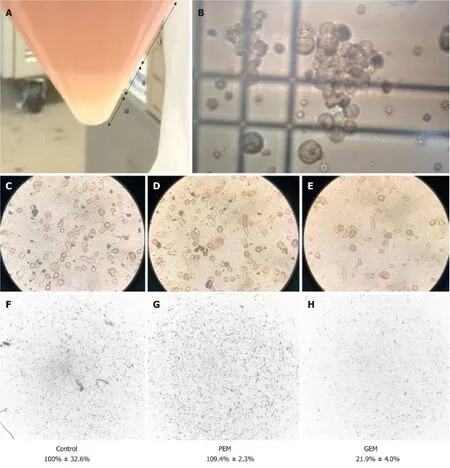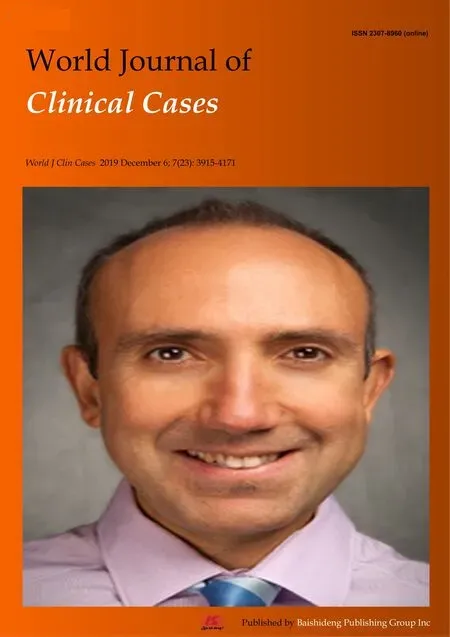In-vitro proliferation assay with recycled ascitic cancer cells in malignant pleural mesothelioma:A case report
Takashi Anayama, Mai Taguchi, Takehiro Tatenuma, Hironobu Okada, Ryohei Miyazaki, Kentaro Hirohashi,Motohiko Kume, Keisuke Matsusaki, Kazumasa Orihashi
Takashi Anayama, Mai Taguchi, Takehiro Tatenuma, Hironobu Okada, Ryohei Miyazaki, Kentaro Hirohashi, Motohiko Kume, Kazumasa Orihashi, Department of Surgery II, Kochi Medical School, Kochi University, Kochi 783-8505, Japan
Keisuke Matsusaki, Japanese CART Study Group, Kaname Second Clinic, Kanamecho Hospital, Tokyo 171-0043, Japan
Abstract
Key words: Ascites; Cancer; Malignant; Mesothelioma; Pemetrexed; Palliative therapy;Case report
INTRODUCTION
Malignant mesothelioma is a rare and insidious neoplasm with a poor prognosis.Pemetrexed-cisplatin (PEM-CDDP) combination therapy was established as a standard treatment with level I evidence and grade A recommendation[1].Only patients with favorable prognostic features, histology, and staging are referred for radical treatment involving extensive cytoreductive surgery consideration[2].For cure,two radical surgical procedures, extra-pleural pneumonectomy (EPP) and pleurectomy/decortication, are performed in combination with chemotherapy and/or radiotherapy.A systematic review showed that the median overall survival after EPP was 9.4–27.5 mo, with a 5-year survival rate of 0%–24%[3].
Ascites is a unique form of malignant pleural mesothelioma (MPM) recurrence[4].Although puncture and aspiration can improve the symptoms of ascites, repeated procedures result in loss of large amounts of electrolytes and albumin.Cell-free and concentrated ascites reinfusion therapy (CART) was developed as a palliative therapeutic option for controlling massive ascites and improving the patient’s quality of life[5,6].KM-CART, a novel CART system developed in 2011, is a highly efficient method of processing tumor cell-rich malignant ascites[7,8].In this report, we described a case of massive ascites due to recurrent MPM that was controlled using KM-CART.Here, the tumor cells derivedviaKM-CART were utilized secondarily in anin-vitrocell growth assay using the collagen gel droplet-embedded culture drug sensitivity test (CD-DST) to investigate anticancer drug susceptibility[9,10].
CASE PRESENTATION
Chief complaint
A 56-year-old man presented to our hospital with right pleural effusion.
History of present illness
The patient had a long history of outpatient treatment for hypertension.Although he was asymptomatic, a routine chest computed tomography (CT) scan revealed the presence of pleural effusion in the right lung.
History of past illness
He had no prior history of hospitalization, operations, or injuries.
Personal and family history
He had no significant childhood illnesses.His deceased parents had no history of malignancy.He had two healthy siblings.He had a 30-year smoking history of 1 pack/d between the ages of 20 and 56 years (30 pack/year).He was occupationally exposed to asbestos from the age of 24 to 30 years.
马克思的劳动概念是批判资本主义社会的有力武器,它是映照资本主义生产方式不够自由的镜子。马克思的劳动概念揭示了资本主义社会中雇佣劳动的剥削本质,揭开了资本主义商品拜物教的秘密。
Physical examination upon admission
Upon physical examination, his respiratory sounds were slightly attenuated in the right back.His cervical, supraclavicular, and axillary lymph nodes were not palpable.
Laboratory examinations
Preoperative complete blood count and biochemical examination of blood showed almost normal findings.The levels of serum tumor markers such as squamous cell carcinoma related antigen, cytokeratin fraction, and carbohydrate antigen 19-9 were within normal limits, while elevation of carcinoembryonic antigen level to 10.5 ng/mL (< 5.0 ng/mL) was observed.
Imaging examinations
A chest radiograph and chest CT revealed right pleural effusion, but no tumorous shadow was pointed out in the chest.Cytological examination of the right pleural effusion, sampledviathoracentesis, revealed malignant mesothelioma cells.He had been diagnosed with c-T1aN0M0 c-stage IA[11]malignant pleural mesothelioma..
He underwent right EPP and lymph node dissection with curative intent.Pathological examination of the resected tissue yielded a diagnosis of diffuse MPM,epithelioid type, p-T2N2M0, and p-Stage III.He did not receive postoperative adjuvant chemotherapy.Thirteen months after operation, multiple pulmonary metastases were detected on F-18 fluorodeoxyglucose positron emission tomography/computed tomography (FDG-PET/CT) (Figure 1).The patient refused CDDP/PEM treatment because of the anticipated side effects of CDDP; he received 8 mo courses of single-agent PEM therapy (500 mg/m2) and achieved stable disease[12].
Twenty-one months post-surgery, the patient was re-hospitalized because of abdominal pain and tightness, dyspnea, and anorexia due to massive ascites.Accordingly, we diagnosed recurrent mesothelioma presenting with massive malignant ascites.
FINAL DIAGNOSIS
The final diagnosis was recurrent mesothelioma presenting with massive malignant ascites.
TREATMENT
KM-CART was performed as a palliative treatment (Figure 2).An 8-Fr trocar tube was inserted into the Douglas pouch under local anesthesia for ascitic fluid discharge into a dedicated bag.The discharged fluid, with a total volume of 4050 mL, was filtered and concentrated, while raw ascites was drained from the body.The filtrate concentrate, with a fluid volume of 610 mL and protein concentration of 8.0 g/dL,was reinfused intravenously into the patient.After KM-CART therapy, the patient's body weight decreased by 1.7 kg, his abdomen flattened, and the abdominal pain and dyspnea quickly disappeared.He was able to ingest a normal amount of food the following day.
Then the recycled 5.4 × 108tumor cells were subjected to CD-DST according to a previously reported method[10-13].The isolated malignant mesothelioma cells were less susceptible to previously used systemic chemotherapy agent PEM (109.4% growth rate relative to the normal control).The other agents such as CDDP, carboplatin,nedaplatin, paclitaxel, docetaxel, and vinorelbine also exhibited less susceptible.However, the tumor cells were sensitive to gemcitabine (GEM) (growth rate reduction to 21.9% relative to the normal control) (Figure 3).Therefore, we administered two courses of second-line GEM chemotherapy (1000 mg/m2on days 1, 8, and 15).
OUTCOME AND FOLLOW-UP
Although the patient received palliative treatment, he died 2 years and 4 mo after the initial surgery.However, we observed no increase in the amount of ascites following KM-CART, during GEM therapy, or until 4 mo before death.The overall timeline of treatments and outcomes is presented in Figure 4.
DISCUSSION
MPM may spread to various locations.Local recurrence is generally associated with lymph node disease (65%), pleural effusion (64%), chest wall involvement (43%),contralateral lung disease (36%), pericardial infiltration (29%), and pericardial effusion (12%).Patterns of distal spreading are characterized by parenchymal lung metastasis (27%) and peritoneal/omental disease (24%) with malignant ascites in 16%of cases.These conditions are often followed by bone metastasis (20%) and the development of subcutaneous metastatic nodules (19%)[14].

Figure 1 Postoperative recurrence of malignant mesothelioma.
The patient exhibited recurrent mesothelioma presenting with massive malignant ascites during systemic chemotherapy with PEM.Generally, the fluid associated with ascites is removed by paracentesis in order to relieve abdominal pain as needed as part of palliative care.KM-CART, a unique approach to CART developed by Dr.Matsusakiet al[8]involves a simple and innovative system consisting of an infusion pump and a suction system.Here, the ascitic fluid is filtered from the outside to the inside of the filtration membrane, in the opposite direction to the hemodialysis system.Therefore, clogging of the filtration membrane can be eliminated by a reversedirection (i.e.inside to outside) bolus flush of physiological saline in the CART system circuit.The flushed cancer cells can then be stored in an isolated bag and utilized forin vitrogrowth assay.
CD-DST is a culture-based anticancer drug susceptibility test that uses fresh tumor tissues obtained from various excised solid tumors that have a high probability of growth inin vitroenvironments.The usefulness of CD-DST has been demonstrated in lung cancer[15-17], gastric cancer[18], colorectal cancer[19,20], and MPM studies[21].In our case, the cultured cancer cells were resistant to PEM but highly sensitive to GEM.Therefore, second-line chemotherapy with GEM enabled the patient to maintain stable disease for 4 mo.
This case report had one important limitation.CD-DST is anin vitrogrowth assay that originally utilized highly viable fresh cancer cells excised surgically; malignant mesothelioma cells extracted from ascites may exhibit lower viability than to those extracted from a surgical specimen.It is possible that the low viability may have affected thein vitrogrowth rate success of the assay.We recommend further comparisons to clarify this point.
CONCLUSION
To the best of our knowledge, this is the first report of the use of KM-CART and CDDST of recycled massive ascitic cancer cells.The combination of these two techniques may provide a unique option for personalized treatment of massive malignant ascites.

Figure 2 Use of KM-cell-free and concentrated ascites reinfusion therapy and collagen gel droplet-embedded culture drug sensitivity test.

Figure 3 Collagen gel droplet-embedded culture drug sensitivity test assay of mesothelioma cells obtained from ascites.

Figure 4 A flowchart depicting the timeline of treatment and outcomes.
ACKNOWLEDGEMENTS
We would like to express our special thanks and gratitude to Ms.Yoko Asakura and Miss Ami Yamanaka, who provided technical assistance with thein vitroCD-DST assay, and to Mr.Masahiro Yokoi, the technical adviser of the Japanese CART study group, who provided technical assistance with KM-CART.
 World Journal of Clinical Cases2019年23期
World Journal of Clinical Cases2019年23期
- World Journal of Clinical Cases的其它文章
- Overview of organic anion transporters and organic anion transporter polypeptides and their roles in the liver
- Value of early diagnosis of sepsis complicated with acute kidney injury by renal contrast-enhanced ultrasound
- Value of elastography point quantification in improving the diagnostic accuracy of early diabetic kidney disease
- Resection of recurrent third branchial cleft fistulas assisted by flexible pharyngotomy
- Therapeutic efficacy of acupuncture combined with neuromuscular joint facilitation in treatment of hemiplegic shoulder pain
- Comparison of intra-articular injection of parecoxib vs oral administration of celecoxib for the clinical efficacy in the treatment of early knee osteoarthritis
